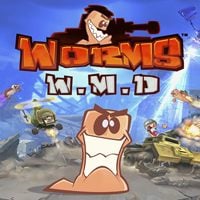Worms WMD review – Going back to Armageddon
Worms WMD is a perfect mix of the old and the new, especially since this game is closest to bringing back the experience of the best installments in the series while introducing some new stuff at the same time.
The review is based on the PC version. It's also relevant to PS4, XONE, Switch version(s).
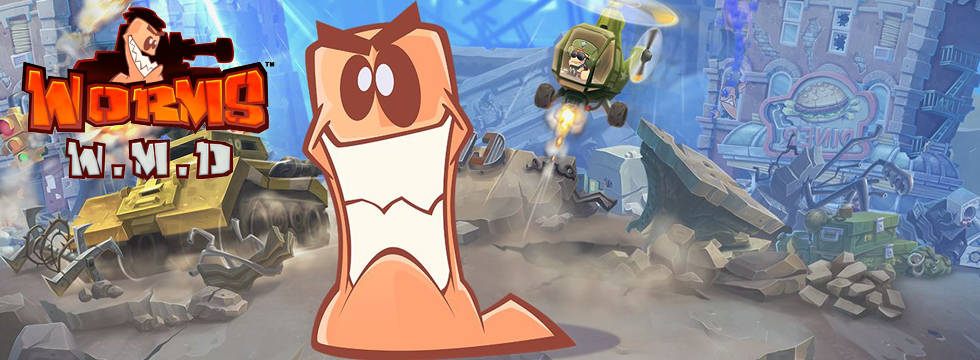
- Physics straight from Worms: Armageddon;
- Limit of worms increased up to 48 per map;
- New features really spice up the gameplay;
- Huge weapon arsenal;
- Visuals are easy on the eye;
- If you have someone to play with, it’s ten times more fun.
- Some good functions from previous games are not here anymore;
- Missing iconic weapons;
- Playing against the AI is still not as fun as playing against a living opponent.
The Worms series is one of the few franchises that lost quite a lot due to the transition to three dimensions. At the turn of the century these 2D games were among the most popular series when you felt like playing together with your friends. This changed with the release of Worms 3D and several consecutive installments – ever since, fans have been turning their backs on their former favorite. Eventually, someone noticed how bad a move that was, and the game was brought back to two dimensions, but the franchise never really managed to regain what it had already lost. And it’s actually the developer – Team 17 – who’s to blame for this situation. With every 2D sequel they introduced some new, often great, ideas, only to give up on them in a following installment and replace them with something completely different. What’s more, their games kept missing the crucial features that the original Worms games had been praised for. As a result, every recent game was decent but also somewhat lacking in comparison to Worms: Armageddon and Worms World Party, the titles that the fans loved so much.
All the initial announcements regarding Worms WMD suggested that it would be no different this time around – we were supposed to get features like getting inside buildings and vehicles while the devs pretended that worm classes and interactive water never existed in Worms: Revolution. That’s why I suspected that, just like Reloaded, Revolution and Clan Wars, the newest installment will be okay but nowhere near close to its cult predecessors. Now I’m left positively surprised, as WMD, although not better than the best Worms games, is certainly not any worse either! All thanks to one element of the game – physics.
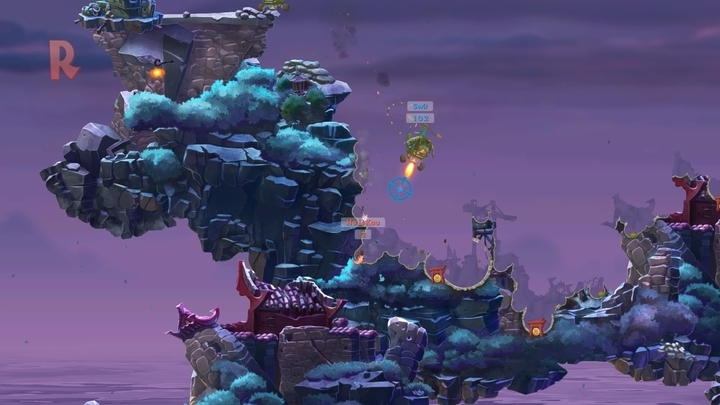
Destroy!
Rules of engagement stay the same – teams consisting of a certain number of worms try to annihilate each other with more or less bizarre weapons. Everything is done in turns on 2D maps that can easily get leveled with every explosion – to be precise, they can be leveled until the moment you reach the deadly (for our worms at least) water. Although these rules seem trivial, they proved again and again that there is a lot of depth and multiplayer potential here; no member of Team 17 even considered changing the basics, at the same time adding various new mechanics to complement them. And it’s not very different this time around, but we’re also going back to the fondly remembered past.
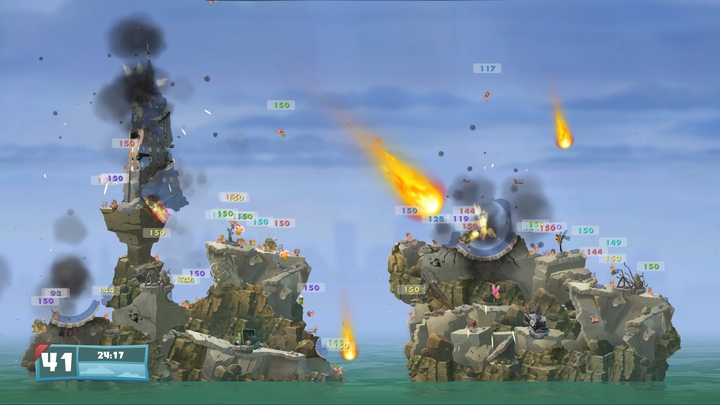
Right after you launch the game, you’re going to get a little nostalgic – all thanks to the new version of the main theme that goes way back to the first Worms game. The real joy begins when you start a match and realize that the physics of WMD are almost an exact copy of the one that were used in Armageddon and World Party. No more stuff that we hated in Revolution and Clan Wars: “heavy” worms, much smaller blast area from explosions, baseball bat or fire punch, drastically weaker banana bomb or pitiful Armageddon. Our worms are once again very mobile, and the most powerful weapon can obliterate half of the map with just one shot. And yes – the fan favorite rope is once again extremely overpowered; although it takes a lot of training to really master its use, once you do, you’re going to be able to get everywhere you want. I liked the new installments in the series because of some interesting game mechanics and I often felt that people were prejudiced against all the 3D Worms games; however, the older physics engine was working much better and remaking it now was the best thing that could be done. Battles of worms in the past few games were merely fun, but the ones in WMD are hilarious and engaging for the player. Just like the ones in Armageddon. Okay, sometimes it’s even better, because the newest title from Team 17 adds many fresh ideas to the mix (while unfortunately not keeping some of the good ones from the post-3D era games).
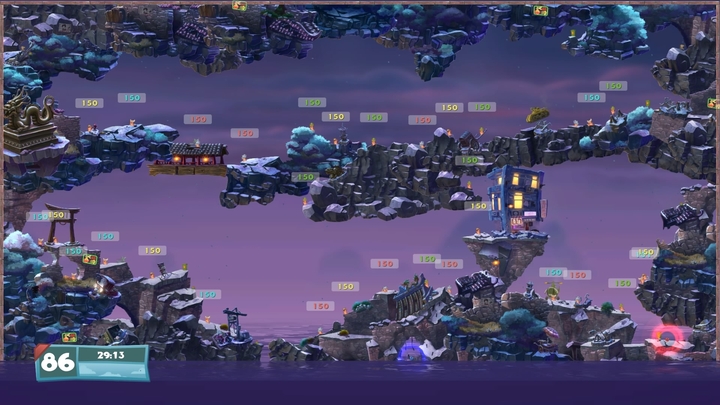
Annihilate!
The biggest novelty in WMD are three vehicle types that our worms can find on the battlefield (there’s also the fourth one available only for people who pre-ordered the game). Every worm that gets near one of the vehicles can get inside, even if the enemy is in it, and then use it to swiftly travel across the map or wreak havoc. Each vehicle offers completely different options and it’s supposed to be used for different types of actions. A tank is mainly a tool of destruction – it attacks by shooting six projectiles in total, and although they don’t cause too much damage, they can seriously remodel the map. A helicopter is a great way of moving around the map, and if you want to you can use its not-so-precise-but-deadly machine gun. A mech, on the other hand, is a beast used for close combat – if you aim it right, you can launch the enemy into the air for a really long flight.
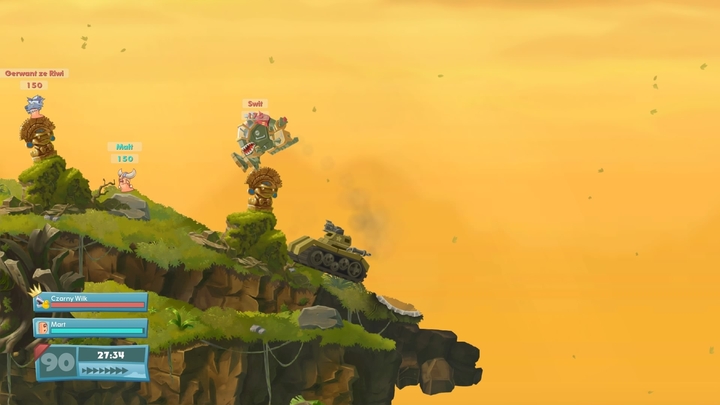
Apart from the mobile vehicles, there are stationary weapons scattered all around the map. These are more deadly versions of standard weapons – a minigun, a flamethrower and a sniper rifle (it works just like a shotgun, but it has only one shot, deals greater damage and is much easier to aim). Both the vehicles and stationary weapons turn out to provide quite an interesting variety for every match – on the one hand, they are powerful enough for you to want to get to them and use them, but at the same time the advantage they give won’t tip the scales of the battle.
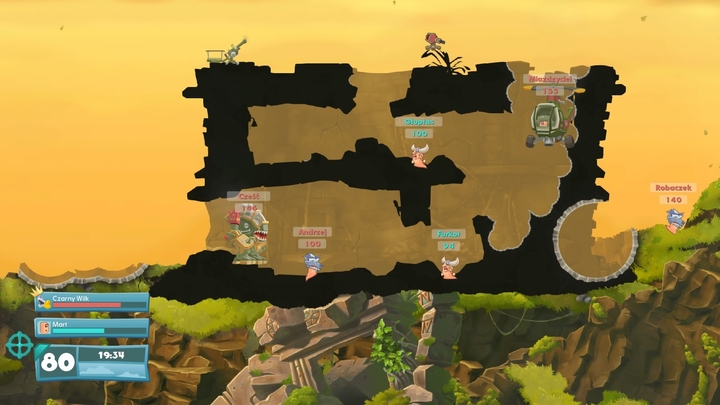
The second thing, although not as impressive, are the buildings. Randomly placed constructions are different from other parts of the map mostly because only a team that already has at least one worm in it can see what’s inside. In doesn’t change much in a local multiplayer, because you can always see everything during your enemy’s turn, but during single player campaign or multiplayer matches, you get an opportunity to surprise your opponents.
Some crafting too
At first glance Worms WMD offers pitifully few weapons – there are only 30 icons in the weapons selection menu. However, it quickly turns out that this isn’t the case and the actual number of weapons is over twice as big. All of that is made possible by a certain new aspect of mechanics – a crafting system. During the game we can collect four different crates with various resources or deconstruct unnecessary stuff. Thanks to these resources you can improve your arsenal – either with regular toys or their upgraded versions. For example, dynamite is available in a regular version, as well as the upgraded one, which not only explodes, but also poisons the enemies. A bazooka can get a special add-on that sprays napalm around the point of impact. There is one catch here, though – crafting items takes a while, so we need to foresee and begin production in advance. Luckily, you don’t need to waste time for these decisions during your turn – you can focus on crafting while your enemies are making their moves. This system is pretty similar to buying weapons for coins in Worms Revolution, but it’s been thought-over much better and using it actually makes more sense.
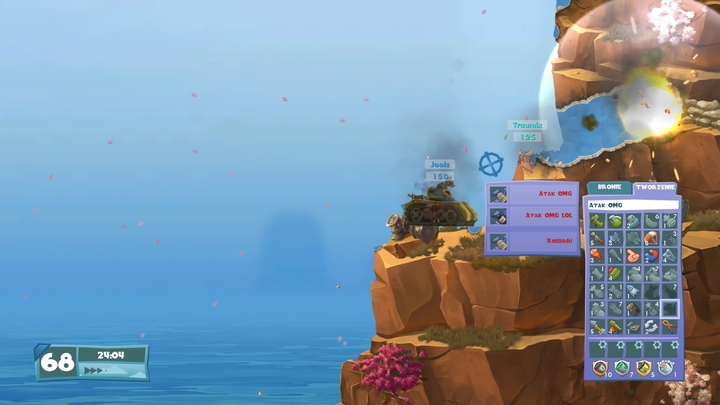
Most of the classic weaponry found its way into the game – there’s a bazooka, there are grenades, various forms of sheep, banana bombs, a concrete donkey or a holy hand grenade. Magnets are back, as well as now-much-more-dangerous sentry turrets and a bunker buster. What stands out among the new stuff are things like a sheep on a rope, which will be a wet dream of every fan of Worms rope play, or an unwanted present that lies there for a couple of turns and finally explodes – the longer it remains untouched, the bigger the explosion. Even though the game has one of the biggest arsenals in the history of the series, some of the iconic tools – like the pigeon or mad cows – are still missing. Since the interactive water and some objects from Revolution and Clan Wars were scrapped, related tools like telekinesis, water gun, flying monkey or a water barrage are missing as well.
Go to hell, you worm!
What really mattered in the franchise was the multiplayer, but some installments could also take pride in quite extensive and often crazy single player modes. WMD is no worse in that matter, as it offers a series of training mission that will make it easier to familiarize the players with the basics, the most problematic weapons and new mechanics; it also provides quite an extensive campaign that consists of 30 missions, and a challenge mode.
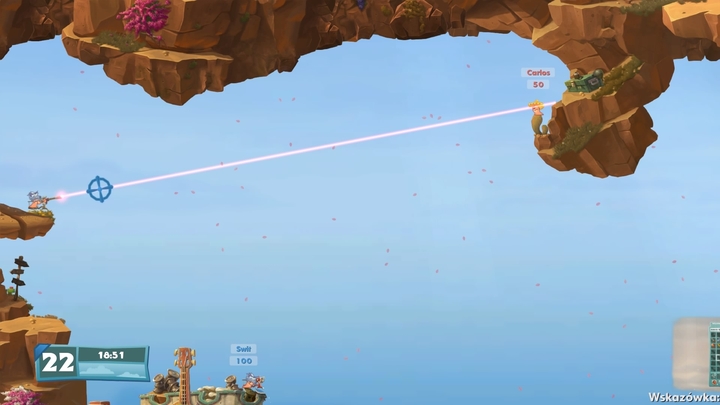
I guess I would put the experience coming from the campaign somewhere between the craziness of missions straight from the best games in the series and the extremely boring mode from Worms Revolution. For most of the time your task is to eliminate all enemy worms, sometimes we have to keep a certain worm safe, take out one specific enemy or find a heavily guarded crate. It’s a completely common way of doing the campaign, which only becomes diversified thanks to optional side tasks that require some finesse on the player’s part. What’s lacking is the humor characteristic for the series, which was usually visualized through mission briefings or descriptions. Unfortunately, the whole thing is quite stiff for most of the time, and only the cutscenes that appear every once in a while make you smile a little. On the plus side, the challenge mode is really good and you can unlock it by collecting special posters in solo mode. Among these ten you can find missions that will make you think a lot and use game mechanics in an unusual way. In general, single player modes will keep you occupied somewhere between a dozen and several dozen hours, but you need to remember that just like previously in the series, this is only a side dish for the main course that is the multiplayer; and as such, it works great in smaller amounts.
The multiplayer offers quite a nice variety of configuration options that include turning off all of WMD mechanics – in case you wanted to play a match governed by the classic rules. Many players will consider the following thing the most important change in the game: the number of worms per map has been increased, and now you can have up to 6 teams with 8 worms per team on a single map – and that gives you a total of 48 fighters. Match settings fall behind Worms World Party, which had the biggest number of available options in the series: there is no fort mode or manual map editor (you can only set some parameters and have the generator create a map according to these settings). However, increasing the number of worms per map is already a big step in the right direction.
Since I played the game before the world release, I couldn’t really check how the game works in multiplayer matches. Luckily, the developers from Team 17 gave up on the idea of clans, which turned out to be a total disaster, and now they only offer classic matches with random people or with your friends, as well as ranked 1 vs 1 matches.
Well Made Demolition
After seeing the first promo materials, my attitude towards the visuals of WMD was quite negative, especially when it concerned the worms themselves. I must admit that I was wrong – coming back to the cartoonish style looks well and after the first few minutes I got used to how our little crawlers look like. It was easy to accept the new art style thanks to maps that look really amazing – although they are generated automatically according to certain settings, they’re full of details and show what proper 2D games may look like if you get rid of the lately overused pixel art. What’s equally important, the maps are really clear – there’s no more blending of the background with a piece of land that resulted in the player wondering which one is an obstruction and which one is just there to look pretty.
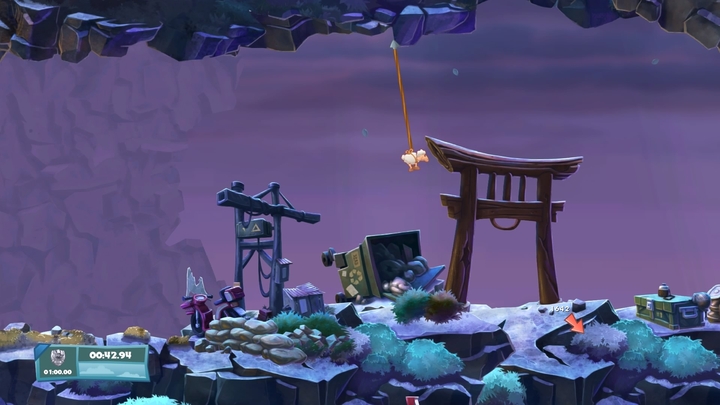
Game engine was properly optimized and despite enormous destruction happening all the time, I didn’t notice any frame drops. With one, actually quite funny, exception: FPS can suddenly drop when the AI-controlled worm is thinking of his next move. It’s strange because the algorithms behind the worms are what they used to be: they either behave utterly absurd or they’re extremely precise and do things that no living player could replicate. Apart from this single problem, the game got a lot of love from the devs – I encountered no errors over the course of a few dozen matches.
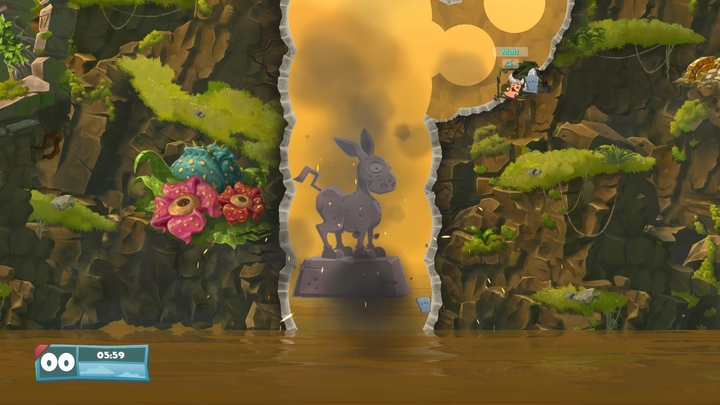
It’s been a long time since worms got a game that would match the iconic titles from the pre-3D era, but it was worth the wait. Surprisingly, the key to success is not to come up with more crazy ways of varying the game – although their presence is definitely a plus – but rather to go back to the roots and give the fans what they missed the most: more worms, classic physics and no limitations in terms of destruction. Although I would love to see some elements that were introduced in the Worms games in the past few years – mostly forts from World Party, vertically-built levels from Reloaded and water from Revolution – classic physics and a huge arsenal of weapons with some nice additions made this game so fun to play that it’s easy to forget all the small drawbacks that WMD has. Just keep in mind that Worms are served best with multiplayer, because by playing on your own you miss out on a lot that the game has to offer. This is exactly the comeback of Worms that all the fans have been waiting for!
Worms W.M.D
Worms WMD review – Going back to Armageddon
Worms WMD is a perfect mix of the old and the new, especially since this game is closest to bringing back the experience of the best installments in the series while introducing some new stuff at the same time.

